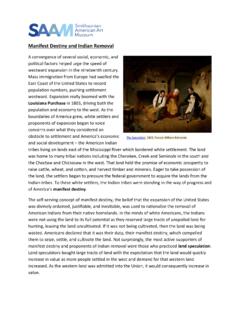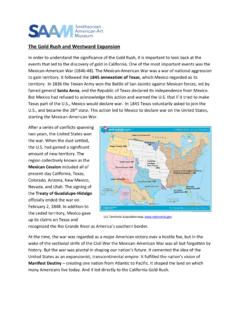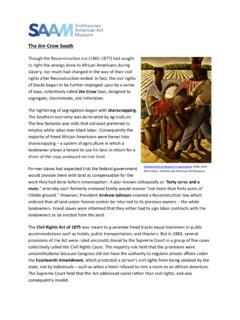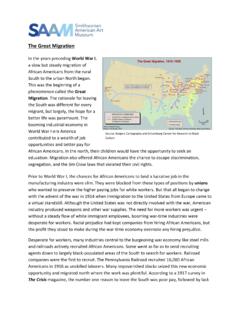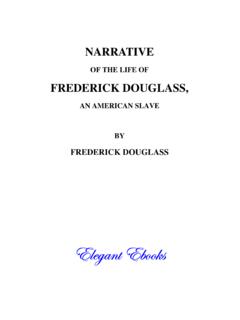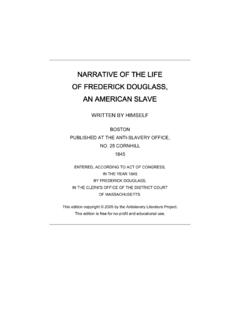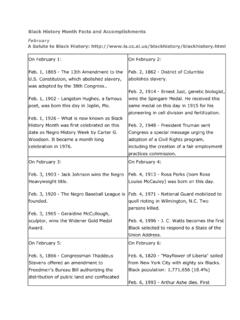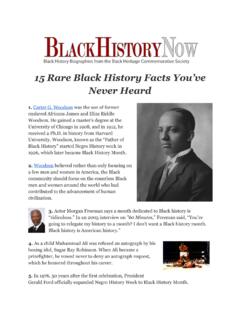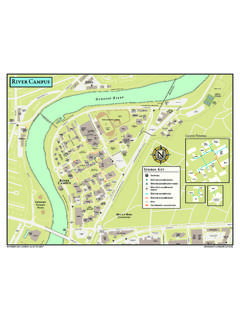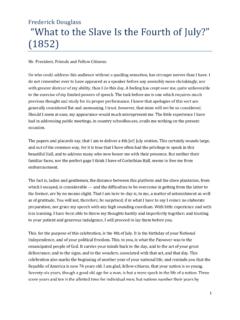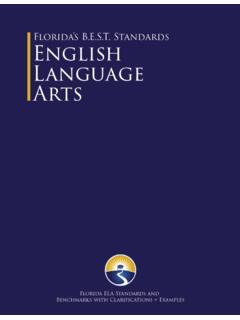Transcription of Literacy as Freedom - American Experience
1 Literacy as Freedom As we look upon this young black man reading a Bible, one question that comes to mind is whether or not the subject is an enslaved person. If he is a free man in the North, it would be legal for him to read at this time in 1863. But what if he is not free? Or what if he is a free black man residing in a slave state? The issue of Literacy among blacks during the Civil War was a complicated one. Before the 1830s there were few restrictions on teaching slaves to read and write. After the slave revolt led by Nat Turner in 1831, all slave states except Maryland, Kentucky, and Tennessee passed laws against teaching slaves to read and write. For example, in 1831 and 1832 statues were passed in Virginia prohibiting meetings to teach free blacks to read or write and instituting a fine of $10 $100 for teaching enslaved blacks.
2 The Alabama Slave Code of 1833 included the following law [S31] Any person who shall attempt to teach any free person of color, or slave, to spell, read or write, shall upon conviction thereof by indictment, be fined in a sum of not less than two hundred fifty dollars, nor more than five hundred dollars. At this time, Harpers Weekly published an article that stated the alphabet is an abolitionist. If you would keep a people enslaved refuse to teach them to read. There was fear that slaves who were literate could forge travel passes and escape. These passes, signed by the slave owner, were required for enslaved people traveling from one place to another and usually included the date on which the slave was supposed to return. There was also fear that writing could be a means of communication that would make it easier to plan insurrections and mass escapes.
3 Slave narratives from many sources tell us how many enslaved people became educated. Some learned to read from other literate slaves, while at other times a master or mistress was willing to teach a slave in defiance of the laws. Former slave and abolitionist leader frederick douglass was taught the alphabet in secret at age twelve by his master s wife, Sophia Auld. As he grew older douglass took charge of his own education, obtaining and reading newspapers and books in secret. He was often quoted asserting that knowledge is the pathway from slavery to Freedom . douglass was one of the few literate slaves who regularly taught others how to read. Younger slaves frequently listened outside school houses where their masters children were learning. Enslaved people who were Sunday Morning, ca. 1877, Thomas Waterman Wood, oil on paperboard, Smithsonian American Art Museum caught reading or writing were severely punished, as were their teachers.
4 In every instance these slaves and those who taught them undertook a profound risk, which for many was surmounted by the individual s passion, commitment and imagination. The following are two telling examples of slave narratives that discuss how slaves became literate. This first account is from James Fisher of Nashville, Tennessee, who relayed his story in 1843: I .. thought it wise to learn to write, in case opportunity should offer to write myself a pass. I copied every scrap of writing I could find, and thus learned to write a tolerable hand before I knew what the words were that I was copying. At last, I found an old man who, for the sake of money to buy whisky, agreed to reach me the writing alphabet, and set up copying. I spent a good deal of time trying to improve myself; secretly, of course.
5 One day, my mistress happened to come into my room, when my materials were about; and she told her father (old Capt. Davis) that I was learning to write. He replied, that if I belonged to him, he would cut my right hand off. Artist Eastman Johnson was active in the abolitionist movement in the 1860s, so it is plausible that he read slave narratives that demonstrated the importance of Literacy and, specifically, the reading of the Bible to slaves and former slaves. One possible source Johnson might have come across was the narrative of former slave James Curry, published in the abolitionist newspaper The Liberator on January 10, 1840. Curry recalls his quest to learn to read: My master s oldest son was six months older than I. He went to a day school, and as I had a great desire to learn to read, I prevailed upon him to teach me.
6 My mother procured me a spelling-book. (Before Nat Turner s insurrection, a slave in our neighborhood might buy a spelling or hymn-book, but now he cannot). I got so I could read a little, when my master found it out, and forbad his son to teach me any more. As I had got the start, however, I kept on reading and studying, and from that time till I came away, I always had a book somewhere about me, and if I got an opportunity, I would be reading in it. Indeed, I have a book now, which I brought all the way from North Carolina. I borrowed a hymn-book, and learned the hymns by heart. My uncle had a Bible, which he lent me, and I studied the Scriptures. When my master s family were all gone away on the Sabbath, I used to go into the house and get down the great Bible, and lie down in the piazza, and read, taking care, however, to put it back before they returned.
7 There I learned that it was contrary to the revealed will of God, that one man should hold another as a slave. I had always heard it talked among slaves, that we ought not to be held as slaves; that our forefathers and mothers were stolen from Africa, where they were free men and free women. But in the Bible I learned that God hath made of one blood all nations of men to dwell on all the face of the earth. Slave Education and the Union Army In the effort to forge a new identity after their emancipation, former slaves realized that the key to empowerment was Literacy . Slaves who tended to young white children, helping to dress them and carry their books to school, watched as they grew into successful adults and witnessed firsthand the benefits of an education. The lack of reading and writing capabilities was frustrating for many as it hampered the ability to do such simple things as record a marriage or the birth of a child.
8 With emancipation came the chance for freed blacks to acquire the education they had been denied. Eastman Johnson s painting of a freed black man reading the Bible personifies that chance that all newly freed African Americans had to take in order to build a new life. The quest for Literacy was especially important to adult blacks as once they learned how to read, they could then teach their children, producing a new generation of educated freed African Americans. Following the Emancipation Proclamation, Northern whites helped newly freed blacks to construct schools and served as teachers. In Arkansas, a visiting teacher tasked with teaching black soldiers to read and write, recalled that the soldiers "seem to feel the importance of learning and study very hard, helping themselves along very much.
9 " Others observed that since their emancipation, "one of the most gratifying facts developed by the recent change in their condition is, that they very generally desire instruction, and many seize every opportunity in intervals of labor to obtain it. Their determination to obtain Literacy was so great that for many it ranked as high as necessities like food and shelter. Many black soldiers also became part of a movement to educate former slaves. They advocated for the building of schools and the opportunity for others to learn. The soldiers knew that they would need to construct new lives, and education was the key to achieving that goal. Black soldier John Sweeney attested: We have never Had an institutiong [sic] of that sort and we Stand deeply inneed [sic] of instruction the majority of us having been slaves.
10 We Wish to have some benefit of education To make of ourselves capable of buisness [sic] In the future.. We wish to become a People capable of self support as we are Capable of being soldiers.. But Sir What we want is a general system of education In our regiment for our moral and literary elevation. Literate black soldiers also helped to instruct illiterate soldiers to read and write when teachers were not available. For African Americans, Freedom was not something that was gained overnight; for many Freedom came with the Emancipation Proclamation, for others it came when they escaped in the middle of the night and crossed into Union territory, yet for some it occurred when they donned the blue uniform of the Union Army. The army gave freedmen a purpose. Not only were they fighting for their personal right to exist, but also for the country they were indebted to.


